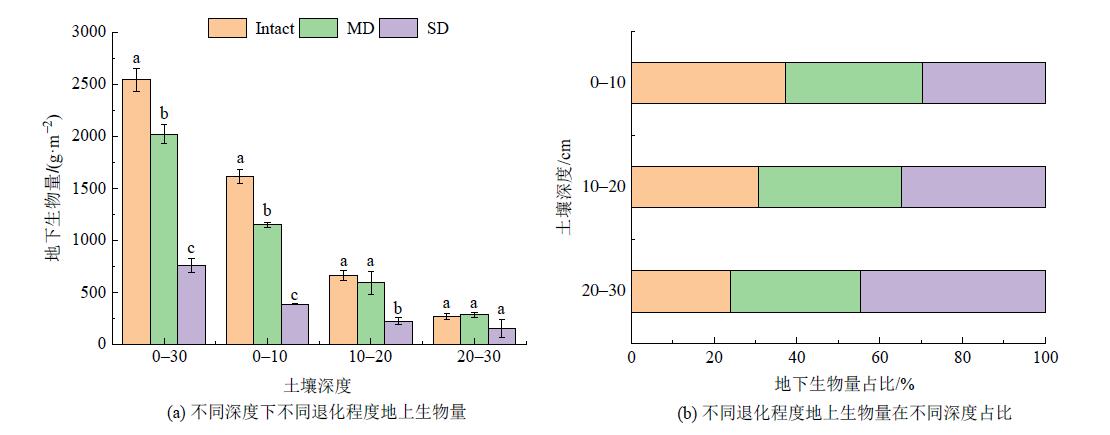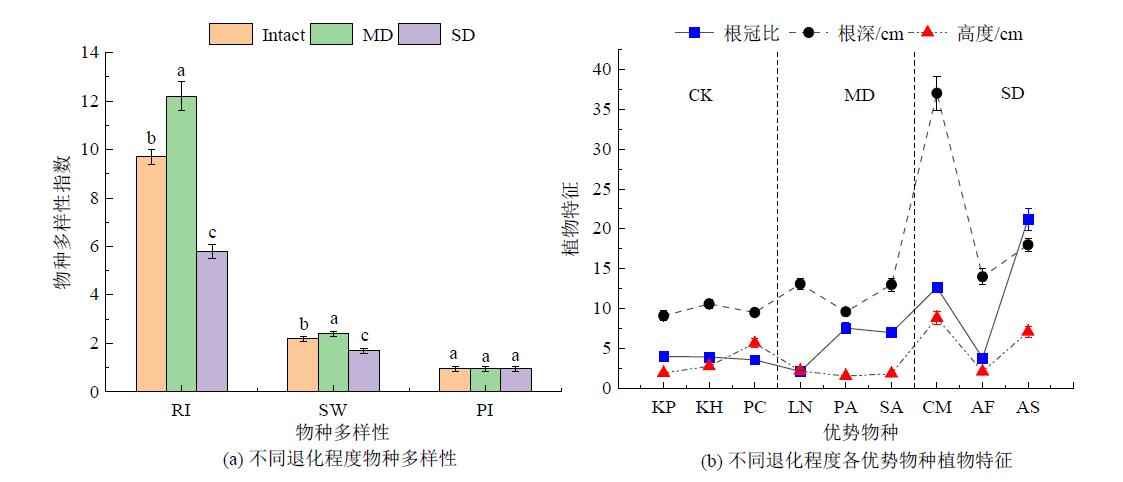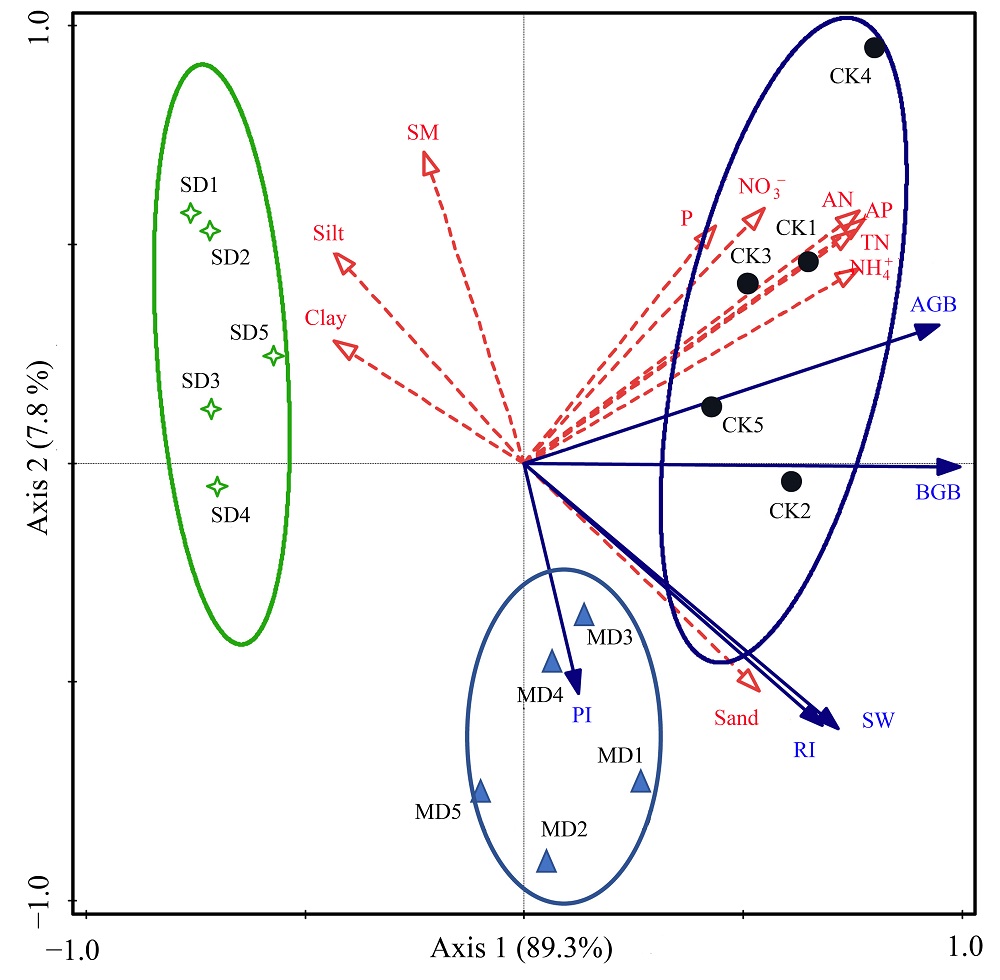生态环境学报 ›› 2024, Vol. 33 ›› Issue (7): 1063-1071.DOI: 10.16258/j.cnki.1674-5906.2024.07.007
李成阳1,*( ), 梁志辉1, 李臻明1, 蔡敏1, 许瑞瑶1, 陈秀宇1, 丁佳音1, 许秋云1, 彭飞2
), 梁志辉1, 李臻明1, 蔡敏1, 许瑞瑶1, 陈秀宇1, 丁佳音1, 许秋云1, 彭飞2
收稿日期:2024-01-18
出版日期:2024-07-18
发布日期:2024-09-04
通讯作者:
*作者简介:李成阳(1992年生),男,讲师,博士,研究方向为草地退化过程和机理。E-mail: lichengyang@lzb.ac.cn
基金资助:
LI Chengyang1,*( ), LIANG Zhihui1, LI Zhenming1, CAI Min1, XU Ruiyao1, CHEN Xiuyu1, DING Jiayin1, XU Qiuyun1, PENG Fei2
), LIANG Zhihui1, LI Zhenming1, CAI Min1, XU Ruiyao1, CHEN Xiuyu1, DING Jiayin1, XU Qiuyun1, PENG Fei2
Received:2024-01-18
Online:2024-07-18
Published:2024-09-04
摘要:
生态系统退化严重威胁着全球生态和环境安全,充分认识退化过程和机理是开展和实现退化生态系统修复的关键。以往大部分高寒草甸退化相关研究缺乏长期的观测资料,难以合理分析退化的形成过程和机理。以具有长期观测资料的长江源多年冻土区北麓河流域未退化和退化高寒草甸为对象,根据研究区实际,探讨了草地退化下植物群落结构特征和土壤理化特性的变化及其相互关系,为查明多年冻土区高寒草甸退化机理和退化草地修复提供理论依据。 结果表明:1)退化使地上和地下生物量显著降低,植物群落优势物种由浅根系的莎草科植物向深根系的杂草类植物转变;2)Shannon-Wiener多样性指数和物种丰富度指数呈单峰变化趋势,即在中度退化阶段显著增加,但在严重退化阶段显著降低;3)退化后,土壤容重、pH和总磷显著增加,但硝态氮、铵态氮、速效氮、总氮和有机碳呈降低趋势;4)冗余分析结果显示,群落生物量与土壤有机碳、总氮、硝态氮、铵态氮、速效氮和速效磷呈正相关,Shannon-Wiener多样性指数和物种丰富度指数与粉粒、水分和pH负相关,速效氮、速效磷、土壤水分对植被生物量和物种多样性的解释率分别为57.8%、27.3%和9.9%。因此,长江源多年冻土区退化高寒草甸植物生长可能主要受速效养分限制,在对其的修复过程中,应首先考虑土壤养分的恢复。
中图分类号:
李成阳, 梁志辉, 李臻明, 蔡敏, 许瑞瑶, 陈秀宇, 丁佳音, 许秋云, 彭飞. 长江源区北麓河流域退化高寒草甸植物群落特征和土壤特性[J]. 生态环境学报, 2024, 33(7): 1063-1071.
LI Chengyang, LIANG Zhihui, LI Zhenming, CAI Min, XU Ruiyao, CHEN Xiuyu, DING Jiayin, XU Qiuyun, PENG Fei. Plant Community Characteristics and Soil Characteristics of Degraded Alpine Meadows in the Beilu River Basin of the Yangtze River Source Area[J]. Ecology and Environment, 2024, 33(7): 1063-1071.

图1 不同退化程度群落和不同功能群地上生物量及其占群落百分比 不同小写字母表示不同退化程度下各指标差异显著(p<0.05),下同
Figure 1 The aboveground biomass of communities and functional groups with different degrees of degradation and their percentage in the community

图2 草地退化下高寒草甸不同土壤深度地下生物量和各层地下生物量占比
Figure 2 The belowground biomass and percentage belowground biomass at each depth in different degraded alpine meadow

图3 草地退化下高寒草甸物种多样性和各优势物种植物特征 RI:物种丰富度指数;SW:Shannon-Wiener多样性指数;PI:Pielou均匀度指数;KP:高山嵩草,Kobresia pygmaea;KH:矮生嵩草,Kobresia humilis;PC:冷地早熟禾,Poa crymophila;LN:矮火绒草,Leontopodium nanum;PA:星毛委陵菜,Potentilla acaulis;SA:沙生风毛菊,Saussurea arenaria;CM:青藏薹草,Carex moorcroftii;AF:萎软紫菀,Aster flaccidus;AS:高山韭,Allium sikkimense
Figure 3 Species diversity and plant characteristics of each dominant species in alpine meadows at different stages of degradation
| 变异来源 | BD | SM | pH | SOC | TN | NO3− | NH4+ | AN | TP | AP |
|---|---|---|---|---|---|---|---|---|---|---|
| LD | 46.6** 2) | 28.8** | 18.1** | 345.2** | 198.4** | 38.7** | 10.1** | 33.7** | 4.3* 1) | 0.7 |
| D | 7.2** | 0.1 | 13.3** | 58.7** | 73.6** | 6.9** | 19.3** | 25.5** | 1.9 | 0.8 |
| LD×D | 2.4 | 2.6 | 2.8 | 49.8** | 24.0** | 2.2 | 12.3** | 12.6** | 0.7 | 0.9 |
表1 退化(LD),深度(D)和二者交互作用对各指标的双因素方差分析(F值)
Table 1 Grassland degradation (LD), soil depth (D), and their interaction on various indicators based on Two-way ANOVA (F values)
| 变异来源 | BD | SM | pH | SOC | TN | NO3− | NH4+ | AN | TP | AP |
|---|---|---|---|---|---|---|---|---|---|---|
| LD | 46.6** 2) | 28.8** | 18.1** | 345.2** | 198.4** | 38.7** | 10.1** | 33.7** | 4.3* 1) | 0.7 |
| D | 7.2** | 0.1 | 13.3** | 58.7** | 73.6** | 6.9** | 19.3** | 25.5** | 1.9 | 0.8 |
| LD×D | 2.4 | 2.6 | 2.8 | 49.8** | 24.0** | 2.2 | 12.3** | 12.6** | 0.7 | 0.9 |
| 土壤深度/ cm | 退化 程度 | 土壤水分/ % | 土壤容重/ (g∙m−3) | pH | SOC 质量分数/ (g∙kg−1) | TN 质量分数/ (g∙kg−1) | TP 质量分数/ (g∙kg−1) | NO3− 质量分数/ (mg∙kg−1) | NH4+ 质量分数/ (mg∙kg−1) | AN 质量分数/ (mg∙kg−1) | AP 质量分数/ (mg∙kg−1) |
|---|---|---|---|---|---|---|---|---|---|---|---|
| 0‒10 | CK | 27.01±2.02a | 1.00±0.05c | 7.97±0.02c | 21.18±0.91a | 1.37±0.06a | 0.08±0.02b | 16.91±1.77a | 28.61±6.07a | 45.52±6.16a | 2.05±0.33a |
| MD | 20.13±1.05b | 1.23±0.08b | 8.25±0.01b | 6.44±0.31b | 0.52±0.01b | 0.06±0.01b | 4.25±0.57b | 9.93±0.28b | 14.18±0.55b | 1.75±0.25a | |
| SD | 29.35±1.12a | 1.39±0.01a | 8.56±0.01a | 2.96±0.33b | 0.55±0.06b | 0.17±0.04a | 7.60±1.05b | 5.30±0.38b | 12.91±1.01b | 0.74±0.33a | |
| 10‒20 | CK | 32.36±2.14a | 1.17±0.07b | 8.24±0.03c | 10.68±0.68a | 0.76±0.04a | 0.06±0.01b | 9.83±2.09a | 5.85±1.28a | 15.68±3.29a | 1.92±0.36b |
| MD | 25.21±1.28b | 1.36±0.03a | 8.35±0.02b | 5.54±0.32b | 0.45±0.01b | 0.06±0.01b | 3.39±0.41b | 4.49±0.25a | 7.88±0.32b | 2.71±0.1a | |
| SD | 30.03±2.14a | 1.47±0.02a | 8.55±0.02a | 4.31±0.32b | 0.52±0.03b | 0.16±0.01a | 5.19±0.75b | 5.70±0.47a | 10.88±1.09ab | 1.85±0.17b | |
| 20‒30 | CK | 34.32±3.21a | 1.36±0.07b | 8.53±0.2a | 9.76±0.74a | 0.74±0.04a | 0.08±0.01b | 10.77±1.87a | 7.64±1.03a | 18.41±2.22a | 2.43±0.23a |
| MD | 26.10±0.06b | 1.43±0.04a | 8.47±0.01a | 4.62±0.11b | 0.4±0.01b | 0.06±0.01b | 4.29±0.67b | 3.71±0.25b | 8.0±0.76b | 1.91±0.33a | |
| SD | 28.17±1.08b | 1.49±0.02a | 8.66±0.05a | 3.23±0.33c | 0.25±0.03c | 0.14±0.01a | 4.29±0.74b | 0.06±0.01b | 2.43±0.67b | 2.19±0.43a |
表2 不同退化程度下高寒草甸土壤理化性质差异
Table 2 Physical and chemical characteristics of soil in alpine meadows with different degrees of degradation
| 土壤深度/ cm | 退化 程度 | 土壤水分/ % | 土壤容重/ (g∙m−3) | pH | SOC 质量分数/ (g∙kg−1) | TN 质量分数/ (g∙kg−1) | TP 质量分数/ (g∙kg−1) | NO3− 质量分数/ (mg∙kg−1) | NH4+ 质量分数/ (mg∙kg−1) | AN 质量分数/ (mg∙kg−1) | AP 质量分数/ (mg∙kg−1) |
|---|---|---|---|---|---|---|---|---|---|---|---|
| 0‒10 | CK | 27.01±2.02a | 1.00±0.05c | 7.97±0.02c | 21.18±0.91a | 1.37±0.06a | 0.08±0.02b | 16.91±1.77a | 28.61±6.07a | 45.52±6.16a | 2.05±0.33a |
| MD | 20.13±1.05b | 1.23±0.08b | 8.25±0.01b | 6.44±0.31b | 0.52±0.01b | 0.06±0.01b | 4.25±0.57b | 9.93±0.28b | 14.18±0.55b | 1.75±0.25a | |
| SD | 29.35±1.12a | 1.39±0.01a | 8.56±0.01a | 2.96±0.33b | 0.55±0.06b | 0.17±0.04a | 7.60±1.05b | 5.30±0.38b | 12.91±1.01b | 0.74±0.33a | |
| 10‒20 | CK | 32.36±2.14a | 1.17±0.07b | 8.24±0.03c | 10.68±0.68a | 0.76±0.04a | 0.06±0.01b | 9.83±2.09a | 5.85±1.28a | 15.68±3.29a | 1.92±0.36b |
| MD | 25.21±1.28b | 1.36±0.03a | 8.35±0.02b | 5.54±0.32b | 0.45±0.01b | 0.06±0.01b | 3.39±0.41b | 4.49±0.25a | 7.88±0.32b | 2.71±0.1a | |
| SD | 30.03±2.14a | 1.47±0.02a | 8.55±0.02a | 4.31±0.32b | 0.52±0.03b | 0.16±0.01a | 5.19±0.75b | 5.70±0.47a | 10.88±1.09ab | 1.85±0.17b | |
| 20‒30 | CK | 34.32±3.21a | 1.36±0.07b | 8.53±0.2a | 9.76±0.74a | 0.74±0.04a | 0.08±0.01b | 10.77±1.87a | 7.64±1.03a | 18.41±2.22a | 2.43±0.23a |
| MD | 26.10±0.06b | 1.43±0.04a | 8.47±0.01a | 4.62±0.11b | 0.4±0.01b | 0.06±0.01b | 4.29±0.67b | 3.71±0.25b | 8.0±0.76b | 1.91±0.33a | |
| SD | 28.17±1.08b | 1.49±0.02a | 8.66±0.05a | 3.23±0.33c | 0.25±0.03c | 0.14±0.01a | 4.29±0.74b | 0.06±0.01b | 2.43±0.67b | 2.19±0.43a |

图4 植被群落特征(黑色实线箭头)与土壤环境因子(灰色虚线箭头)的关系 图中CK:未退化;MD:中度退化;SD:严重退化;AGB:地上生物量;BGB:地下生物量;RI:物种丰富度;Silt:粉粒;PI:均匀度指数;SM:土壤水分;SW:Shannon?Wiener 多样性指数;Clay:黏粒;NO3?:硝态氮;NH4+:铵态氮;Sand:砂粒;AN:速效氮;AP:速效磷;P:全磷;TN:总氮
Figure 4 Relationship between plant properties (black solid line arrows) and soil properties (gray dashed line arrows) in degraded alpine meadow grassland
| 土壤因子 | 解释力度排序 | 土壤因子对植物变化的 解释量/% | F | p |
|---|---|---|---|---|
| AN | 1 | 57.82 | 27.81 | <0.01** 1) |
| AP | 2 | 27.28 | 21.94 | <0.01** |
| SM | 3 | 9.91 | 21.32 | <0.01** |
| TN | 4 | 0.78 | 1.99 | 0.178 |
| NO3− | 5 | 0.61 | 1.41 | 0.154 |
| NH4+ | 6 | 0.43 | 0.83 | 0.454 |
| Silt | 7 | 0.28 | 0.61 | 0.472 |
| Sand | 8 | 0.19 | 0.54 | 0.494 |
| TP | 9 | <0.10 | <0.10 | 0.954 |
| Clay | 10 | <0.10 | <0.10 | 0.748 |
表3 退化高寒草甸植被要素的环境解释力度和显著性检验结果
Table 3 Proportion of variance in plant properties that is explained by soil properties for degraded alpine meadow grassland
| 土壤因子 | 解释力度排序 | 土壤因子对植物变化的 解释量/% | F | p |
|---|---|---|---|---|
| AN | 1 | 57.82 | 27.81 | <0.01** 1) |
| AP | 2 | 27.28 | 21.94 | <0.01** |
| SM | 3 | 9.91 | 21.32 | <0.01** |
| TN | 4 | 0.78 | 1.99 | 0.178 |
| NO3− | 5 | 0.61 | 1.41 | 0.154 |
| NH4+ | 6 | 0.43 | 0.83 | 0.454 |
| Silt | 7 | 0.28 | 0.61 | 0.472 |
| Sand | 8 | 0.19 | 0.54 | 0.494 |
| TP | 9 | <0.10 | <0.10 | 0.954 |
| Clay | 10 | <0.10 | <0.10 | 0.748 |
| [1] | CHE R X, WANG F, WANG W J, et al., 2017. Increase in ammonia-oxidizing microbe abundance during degradation of alpine meadows may lead to greater soil nitrogen loss[J]. Biogeochemistry, 136(3): 341-352. |
| [2] | CONG W, RUIJVEN J V, MOMMER L, et al., 2014. Plant species richness promotes soil carbon and nitrogen stocks in grasslands without legumes[J]. Journal of Ecology, 102(5): 1163-1170. |
| [3] | DAI L C, FU R Y, GUO X W, et al., 2021. Long-term grazing exclusion greatly improve carbon and nitrogen store in an alpine meadow on the northern Qinghai-Tibet Plateau[J]. Catena, 197: 104955. |
| [4] | DONG Q M, ZHAO X Q, WU G L, et al., 2013. A review of formation mechanism and restoration measures of “black-soil-type” degraded grassland in the Qinghai-Tibetan Plateau[J]. Environmental Earth Sciences, 70: 2359-2370. |
| [5] | DONG S K, WEN L, LI Y Y, et al., 2012. Soil quality effects of grassland degradation and restoration on the Qinghai-Tibetan Plateau[J]. Soil Science Society of America Journal, 76(6): 2256-2264. |
| [6] | HARRIS R B, 2010. Rangeland degradation on the Qinghai-Tibetan plateau: A review of the evidence of its magnitude and causes[J]. Journal of Arid Environments, 74(1): 1-12. |
| [7] | LAI C M, PENG F, SUN J B, et al., 2022. Niche differentiation and higher uptake of available nitrogen maintained the productivity of alpine meadow at early degradation[J]. Biology and Fertility of Soils, 59(1): 35-49. |
| [8] | LI C Y, LAI C M, PENG F, et al., 2021. Dominant plant functional group determine the response of the temporal stability of plant community biomass to 9-year warming on the Qinghai-Tibetan Plateau[J]. Frontiers in Plant Science, 12: 704138. |
| [9] | LI X L, PERRY G, BRIERLEY G, et al., 2014. Quantitative assessment of degradation classifications for degraded alpine meadows (Heitutan), Sanjiangyuan, western China[J]. Land Degradation Development, 25(5): 417-427. |
| [10] | MOU X M, YU Y W, ZHAO C Y, et al., 2022. Sedge replacement by grasses accelerates litter decomposition and decreases organic matter formation in alpine meadow soils[J]. Land Degradation & Development, 33(16): 3260-3270. |
| [11] | PENG F, XUE X, YOU Q G, et al., 2018. Changes of soil properties regulate the soil organic carbon loss with grassland degradation on the Qinghai-Tibet plateau[J]. Ecological Indictors, 93: 572-580. |
| [12] | WANG Y F, LÜ W W, XUE K, et al., 2022. Grassland changes and adaptive management on the Qinghai-Tibetan Plateau[J]. Nature Reviews Earth & Environment, 3(10): 668-683. |
| [13] | XUE X, GUO J, HAN B S, et al., 2009. The effect of climate warming and permafrost thaw on desertification in the Qinghai-Tibetan Plateau[J]. Geomorphology, 108(3-4): 182-190. |
| [14] | YOU Q G, XUE X, PENG F, et al., 2014. Comparison of ecosystem characteristics between degraded and intact alpine meadow in the Qinghai-Tibetan Plateau, China[J]. Ecological Engineering, 71: 133-143. |
| [15] | ZHANG W J, XUE X, PENG F, et al., 2019. Meta-analysis of the effects of grassland degradation on plant and soil properties in the alpine meadows of the Qinghai-Tibetan Plateau[J]. Global Ecology and Conservation, 20(10): e00774. |
| [16] | ZHOU J, LI X R, PENG F, et al., 2021. Mobilization of soil phosphate after 8 years of warming is linked to plant phosphorus-acquisition strategies in an alpine meadow on the Qinghai-Tibetan Plateau[J]. Global Change Biology, 27(24): 6578-6591. |
| [17] |
安克俭, 魏霞, 赵恒策, 等, 2021. 长江源区高寒草原和高寒草甸土壤粒径分布特征[J]. 应用生态学报, 32(2): 433-440.
DOI |
| AN K J, WEI X, ZHAO H C, et al., 2021. Distribution characteristics of soil particle size in alpine steppe and alpine meadow in the source region of the Yangtze River, China[J]. Chinese Journal of Applied Ecology, 32(2): 433-440. | |
| [18] | 杜志勇, 丛楠, 2024. 植被与土壤特征对青藏高原不同程度退化草地的响应研究[J]. 生态学报, 44(6): 2504-2516. |
| DU Z Y, CONG N, 2024. Responses of vegetation and soil characterisitics to degraded grassland under different degrees on the Qinghai-Tibet plateau[J]. Acta Ecologica Sinica, 44(6): 2504-2516. | |
| [19] | 高洋, 王根绪, 高永恒, 2015. 长江源区高寒草地土壤有机质和氮磷含量的分布特征[J]. 草业科学, 32(10): 1548-1554. |
| GAO Y, WANG G X, GAO Y H, 2015. Distribution characteristics of soil organic matter and nitrogen, phosphor content in alpine grassland ecosystem in upper Yangtze River[J]. Pratacultural Science, 32(10): 1548-1554. | |
| [20] | 根呷羊批, 周俗, 杨孔, 等, 2022. 若尔盖县不同退化程度草地植物群落特征及土壤理化性质[J]. 西南民族大学学报(自然科学版), 48(4): 369-378. |
| GEN GA Y P, ZHOU S, YANG K, et al., 2022. Community characteristics and soil physical and chemical properties under different degraded grassland in Zoige, Sichuan[J]. Journal of Southwest University for Nationalities (Natural Science Edition), 48(4): 369-378. | |
| [21] | 李成阳, 2022. 长江源区退化高寒草甸植物——土壤互馈及其机制研究[D]. 北京: 中国科学院大学: 22-23. |
| LI C Y, 2022. Study on Plant-Soil feedbacks and its mechanism of degraded alpine meadow in the source area of the Yangtze River[D]. Beijing: University of Chinese Academy of Sciences: 22-23. | |
| [22] | 李成阳, 赖炽敏, 彭飞, 等, 2019. 青藏高原北麓河流域不同退化程度高寒草甸生产力和群落结构特征[J]. 草业科学, 36(4): 1044-1052. |
| LI C Y, LAI C M, PENG F, et al., 2019. Alpine meadows at different stages of degradation in the Beiluhe Basin of the Qinghai-Tibet Plateau: Productivity and community structure characteristics[J]. Pratacultural Science, 36(4): 1044-1052. | |
| [23] | 李成阳, 张文娟, 赖炽敏, 等, 2021. 黄河源区不同退化程度高寒草原群落生产力、物种多样性和土壤特性及其关系研究[J]. 生态学报, 41(11): 4541-4551. |
| LI C Y, ZHANG W J, LAI C M, et al., 2021. Plant productivity, species diversity, soil properties, and their relationships in an alpine steppe under different degradation degrees at the source of the Yellow River[J]. Acta Ecologica Sinica, 41(11): 4541-4551. | |
| [24] |
刘洪来, 鲁为华, 陈超, 2011. 草地退化演替过程及诊断研究进展[J]. 草地学报, 19(5): 865-871.
DOI |
| LIU H L, LU W H, CHEN C, 2011. Research progress of grassland degraded succession and diagnosis[J]. Acta Agrestia Sinica, 19(5): 865-871. | |
| [25] | 刘旻霞, 刘成, 杨春亮, 2024. 甘南高寒草甸退化对植物功能群物种多样性与物种多度分布的影响[J]. 西北植物学报, 44(1): 142-153. |
| LIU M X, LIU C, YANG C L, 2024. Influences of alpine meadow degradation on species diversity and abundance distribution of plant functional groups in Gannan[J]. Acta Botanica Boreali-Occidentalia Sinica, 44(1): 142-153. | |
| [26] |
罗亚勇, 孟庆涛, 张静辉, 等, 2014. 青藏高原东缘高寒草甸退化过程中植物群落物种多样性、生产力与土壤特性的关系[J]. 冰川冻土, 36(5): 1298-1305.
DOI |
|
LUO Y Y, MENG Q T, ZHANG J H, et al., 2014. Species diversity and biomass in relation to soil properties of alpine meadows in the eastern Tibetan Plateau in different degradation stages[J]. Journal of Glaciology and Geocryology, 36(5): 1298-1305.
DOI |
|
| [27] | 尤全刚, 2015. 高寒草甸水热过程及其对草地退化和气候变暖的响应与反馈[D]. 北京: 中国科学院大学: 35-36. |
| YOU Q G, 2015. Impact of grassland degradation and climate warming on water-heat process of alpine meadow and its feedbacks[D]. Beijing: University of Chinese Academy of Sciences: 35-36. | |
| [28] | 周幼吾, 郭东信, 邱国庆, 等, 2000. 中国冻土[M]. 北京: 科学出版社: 57-58. |
| ZHOU Y W, GUO D X, QIU G Q, et al., 2000. Permafrost in China[M]. Beijing: Science Press: 57-58. | |
| [29] |
赵帅, 杨文权, 蔺宝珺, 等, 2023. 祁连山国家公园不同退化高寒草甸植物与土壤特性研究[J]. 草地学报, 31(5): 1530-1538.
DOI |
|
ZHAO S, YANG W Q, LIN B J, et al., 2023. Plant and soil characteristics of different degraded alpine meadows in Qilian Mountain National Park[J]. Acta Agrestia Sinica, 31(5): 1530-1538.
DOI |
| [1] | 张京磊, 王国良, 吴波, 贾春林, 张进红, 周圆, 马冰. 滨海盐碱地苜蓿-小黑麦轮作对土壤细菌和真菌群落多样性与网络结构的影响[J]. 生态环境学报, 2024, 33(7): 1048-1062. |
| [2] | 刘泽碧, 毛旭锋, 吴艺, 宋秀华, 于红妍, 金鑫, 杜凯, 谢顺邦. 海湖湿地水体蓝藻水华期浮游生物群落特征及其影响因素[J]. 生态环境学报, 2024, 33(6): 946-957. |
| [3] | 夏凡, 韩怡蒙, 周剑兴, 谢丹妮. 氮和硫在人为扰动的青藏高原高寒森林中的分布特征[J]. 生态环境学报, 2024, 33(5): 689-698. |
| [4] | 蒋云峰, 严婷, 刘俊男, 马丙增, 王海萌, 窦笑萌. 黑土区农田中型土壤动物群落对免耕玉米秸秆覆盖频率的响应[J]. 生态环境学报, 2024, 33(5): 699-707. |
| [5] | 闫兴蕊, 龚平, 王小萍, 商立海, 李一农, 毛飞剑, 牛学锐, 张勃. 三江源地区土壤和牧草中的有机氯污染物:分布、来源和生态风险[J]. 生态环境学报, 2024, 33(3): 428-438. |
| [6] | 李晴, 张梦悦, 于明乔, 李小璇, 常明, 陈立斌, 丁森. 东莞城市河流大型底栖动物群落结构及影响因子[J]. 生态环境学报, 2024, 33(1): 101-110. |
| [7] | 宋思梦, 林冬梅, 周恒宇, 罗宗志, 张丽丽, 易超, 林辉, 林兴生, 刘斌, 苏德伟, 郑丹, 余世葵, 林占熺. 种植巨菌草对乌兰布和沙漠植物物种多样性与土壤理化性质的影响[J]. 生态环境学报, 2023, 32(9): 1595-1605. |
| [8] | 姜懿珊, 孙迎韬, 张干, 罗春玲. 中国不同气候类型森林土壤微生物群落结构及其影响因素[J]. 生态环境学报, 2023, 32(8): 1355-1364. |
| [9] | 王玉琴, 宋梅玲, 周睿, 王宏生. 黄帚橐吾扩散对高寒草甸土壤理化特性及酶活性的影响[J]. 生态环境学报, 2023, 32(8): 1384-1391. |
| [10] | 梁川, 杨艳芳, 俞姗姗, 周利, 张经纬, 张秀娟. 围网与围塘养鱼下沉积物微生物量和群落结构特征差异[J]. 生态环境学报, 2023, 32(8): 1487-1495. |
| [11] | 陈懂懂, 霍莉莉, 赵亮, 陈昕, 舒敏, 贺福全, 张煜坤, 张莉, 李奇. 青海高寒草地水热因子对土壤微生物生物量碳、氮空间变异的贡献——基于增强回归树模型[J]. 生态环境学报, 2023, 32(7): 1207-1217. |
| [12] | 侯晖, 颜培轩, 谢沁宓, 赵宏亮, 庞丹波, 陈林, 李学斌, 胡杨, 梁咏亮, 倪细炉. 贺兰山蒙古扁桃灌丛根际土壤AM真菌群落多样性特征研究[J]. 生态环境学报, 2023, 32(5): 857-865. |
| [13] | 姜永伟, 丁振军, 袁俊斌, 张峥, 李杨, 问青春, 王业耀, 金小伟. 辽宁省主要河流底栖动物群落结构及水质评价研究[J]. 生态环境学报, 2023, 32(5): 969-979. |
| [14] | 王云, 郑西来, 曹敏, 李磊, 宋晓冉, 林晓宇, 郭凯. 滨海含水层咸-淡水过渡带反硝化性能与控制因素研究[J]. 生态环境学报, 2023, 32(5): 980-988. |
| [15] | 寇祝, 卿纯, 袁昌果, 李平. 西藏东北部热泉水中硫氧化菌的多样性及分布特征[J]. 生态环境学报, 2023, 32(5): 989-1000. |
| 阅读次数 | ||||||
|
全文 |
|
|||||
|
摘要 |
|
|||||
